PENGEMBANGAN PROTOTIPE NAVIGASI AUGMENTED REALITY DENGAN FITUR PENGENALAN SUARA MENGGUNAKAN GDLC STUDI KASUS: DI LINGKUNGAN PENDIDIKAN
DOI:
https://doi.org/10.47080/simika.v8i1.3654Keywords:
Augmented Reality, Educational Environment, Game Development Life Cycle, Navigation Application, Speech RecognitionAbstract
The rapid evolution of digital technology is transforming educational practices, enhancing accessibility and interactivity through innovations like augmented reality (AR) and artificial intelligence (AI). This study aims to develop the PDBI Tour application, an AR-based navigation tool integrated with speech recognition, to improve campus accessibility for new students and promote Politeknik Digital Boash Indonesia, a vocational education in Bogor Regency. A Game Development Life Cycle (GDLC) methodology was adopted, comprising initiation, pre-production, production, testing, beta, and release phases. Data were collected through interviews with promotional teams and prospective students, and prototype design was created using Figma, while Unity was used for production with AR Foundation and Whisper API. Functional testing (black box) confirmed reliable navigation features, and usability testing yielded a 65% satisfaction rate from 25 respondents representation of students in PDBI aged 18-20 years who had tried the prototype, highlighting effectiveness in usability, playability, and accessibility. These findings indicate that the PDBI Tour application prototype meets user needs and offers potential as an immersive navigation and promotional tool. This research demonstrates the GDLC approach’s efficacy in enhancing application development through iterative improvements, validating AR navigation as a powerful tool for interactive and accessible campus experiences.
References
Ariyana, R, Y., Susanti, E., Ath-Tariq, M, R., Apriadi, R. (2022). Penerapan Metode Game Development Life Cycle (GDLC) pada Pengembangan Game Motif Batik Khas Yogyakarta. INSOLOGI: Jurnal Sains dan Teknologi. 10.55123/insologi.v1i6.1129.
Asish, S. M., Kulshreshth, A. K., & Borst, C. W. (2022). Detecting distracted students in educational VR environments using machine learning on eye gaze data. Computers and Graphics (Pergamon), 109, 75–87. https://doi.org/10.1016/j.cag.2022.10.007
Basran, P. S., Ho Synn, S., Marzano, G. A., Maeng, H., & Lotfi-Jam, F. (2024). Open LEARN: Open access linear accelerator education and augmented reality Navigator. Physica Medica, 126(June), 104515. https://doi.org/10.1016/j.ejmp.2024.104515
Chiţiba, C. A. (2012). Lifelong Learning Challenges and Opportunities for Traditional Universities. Procedia - Social and Behavioral Sciences, 46, 1943–1947. https://doi.org/10.1016/j.sbspro.2012.05.408
O’Sullivan, J., Bogaarts, G., Kosek, M., Ullmann, R., Schoenenberger, P., Chatham, C., ... & Lipsmeier, F. (2023). Automatic speech recognition for ASD using the open-source whisper model from OpenAI. In International Society for autism Research (INSAR) 2023 Annual Meeting. INSAR, Stockholm, Sweden.
Dey Hazra, R. O., Paksoy, A., Imiolczyk, J. P., Gebauer, H., Hayta, A., & Akgun, D. (2024). Augmented reality–assisted intraoperative navigation increases precision of glenoid inclination in reverse shoulder arthroplasty. Journal of Shoulder and Elbow Surgery, 1–7. https://doi.org/10.1016/j.jse.2024.05.039
Hasan, N., Soewarno, N., & Isnalita, I. (2019). Pengaruh Teknologi Informasi terhadap Proses Pembelajaran dan Prestasi Akademik Mahasiswa. Jurnal Kajian Akuntansi, 3(1), 68. https://doi.org/10.33603/jka.v3i1.2130
Jin, Z., Goyal, S. B., & Rajawat, A. S. (2024). The Informational Role of Artificial Intelligence in higher Education in the New era. Procedia Computer Science, 235(2023), 1008–1023. https://doi.org/10.1016/j.procs.2024.04.096
Jing, W. (2024). Speech recognition sensors and artificial intelligence automatic evaluation application in English oral correction system. Measurement: Sensors, 32(February), 101070. https://doi.org/10.1016/j.measen.2024.101070
Jingning, L. (2024). Speech Recognition Based on Mobile Sensor Networks Application in English Education Intelligent Assisted Learning System. Measurement: Sensors, 32(October), 101084. https://doi.org/10.1016/j.measen.2024.101084
Mylonas, G., Hofstaetter, J., Giannakos, M., Friedl, A., & Koulouris, P. (2023). Playful interventions for sustainability awareness in educational environments: A longitudinal, large-scale study in three countries. International Journal of Child-Computer Interaction, 35, 100562. https://doi.org/10.1016/j.ijcci.2022.100562
Pringle, J. K., Stimpson, I. G., Jeffery, A. J., Wisniewski, K. D., Grossey, T., Hobson, L., Heaton, V., Zholobenko, V., & Rogers, S. L. (2022). Extended reality (XR) virtual practical and educational eGaming to provide effective immersive environments for learning and teaching in forensic science. Science and Justice, 62(6), 696–707. https://doi.org/10.1016/j.scijus.2022.04.004
Riedl, W., Brown, A., & Rausenberger, J. (2024). An “Agile” project planning course: Learning by doing in process engineering education. Education for Chemical Engineers, 48(April), 15–21. https://doi.org/10.1016/j.ece.2024.04.003
Tarigan, F, V., Dzikri, A. (2022). Implementasi Video Pembelajaran Berbasis Multihost Podcast pada Materi Konsep Multimedia. Journal of Applied Multimedia and Networking (JAMN). Vol. 6, No. 2.
Wang, Y. (2024). An interactive online educational environment to reduce anxiety, improve emotional well-being, and critical thinking for college students. Acta Psychologica, 248(January), 104347. https://doi.org/10.1016/j.actpsy.2024.104347
Watson, M. F. (2023). Nursing students’ perceptions of how the COVID-19 pandemic impacts mental well-being and educational environment. Heliyon, 9(3), e14135. https://doi.org/10.1016/j.heliyon.2023.e14135
Zhou, Z., Oveissi, F., & Langrish, T. (2024). Applications of augmented reality (AR) in chemical engineering education: Virtual laboratory work demonstration to digital twin development. Computers and Chemical Engineering, 188(April), 108784. https://doi.org/10.1016/j.compchemeng












